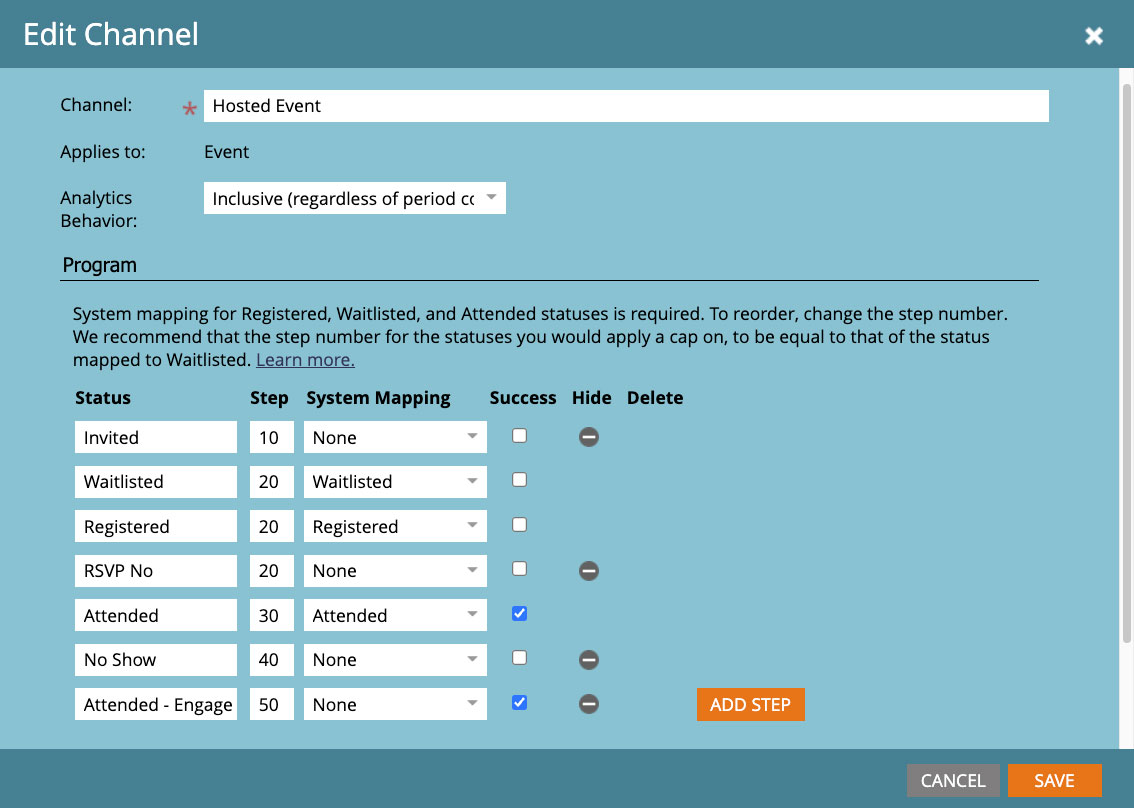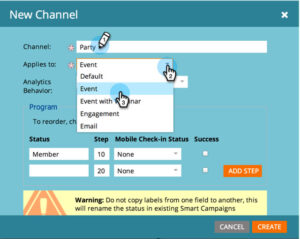Overview
If you’re using Adobe Marketo Engage, the most effective way to track channel engagement and campaign ROI is through properly set-up channels and tags in the system. This will help show which tactics are successful, unsuccessful, and ultimately lead to revenue – but it will also make integrations easier with multi-touch integration tools, business intelligence tools, and even your CRM.
What are channels and tags in Marketo?
Channels and Tags are set up in the Admin section of Marketo. Let’s dive into Channels:
Channels are the different types of marketing tactics or activities you will be conducting using Marketo. You should think of a channel as the delivery mechanism of a marketing initiative. In Marketo Engage, these are tied with one of the program types. In Marketo, programs are the central location for managing each of your marketing activities – the container holding all of the components of a marketing campaign.
There are four:
1. Email Send: For sending emails in a one-off scenario. Easy to set up A/B tests.
2. Event: For use with Trade shows, Webinars, etc.
3. Engagement Program: For Nurture programs
4. Default: For all others
When creating channels, try to keep them high level and use naming conventions to further break out those that require it. When your channel strategy becomes cluttered, it creates confusion with campaign execution, making it hard for campaign management, and can create chaotic reporting.

In Marketo Engage, channels are built with program statuses defined within them, another important component of this platform feature and one you will need to consider as you cannot build a channel without statuses. Program statuses allow you to track and measure an end user’s engagement with or progression through a Marketo program. The statuses make it possible to measure a programs’ effectiveness through the program performance report.

Program statuses are unique and customizable. But they must have one status which is indicated as success which tracks the end users reaching the objective of a given initiative.
Why should MOPs teams care about them?
Channels enable reporting on how marketing tactics are affecting lead creation, lead velocity, opportunity influence, and dollars won.
When set up properly, channels also help describe the journey taken by persons who have become customers, allowing you to “rinse and repeat” with other campaigns. Channels described all of the delivery mechanisms a person engaged with while they were on the buying journey – events, emails, etc.
Channels are also incredibly important as they are the foundation for more advanced reporting, such as multi-touch attribution within Marketo Measure, or business intelligence platforms. Setting these up properly from the get-go will open up a world of possibilities.
Common mistakes when creating channels
Channels should generally never be a one-time use scenario. Oftentimes, harried marketers create a new channel type for a single-use initiative which could have lived under an existing channel type – remember, high level is preferred. Consider how to fit the marketing tactic under a channel which has already been created to avoid channel sprawl and convoluted reporting.
To help determine if you need a new channel, ask yourself if the initiative is a new delivery mechanism or tactic. If it is, you will need a new channel. If it’s not, you should think about how you want to measure the initiative – what defines the goal or objective of the tactic? Do the channels you have already measure success to match your objective within the tactic? There are times when similar tactics measure success differently. In these cases, you many what a new channel with a different success defined.
A common error we see with statuses is to track activity that isn’t related to the channel. For example, a form fill associated with an email campaign, or a lifecycle stage change related to a form fill or nurture program. Keep statuses high level and general. Don’t get too specific as this can also lead to channel sprawl.
It’s also important to remember Marketo already tracks activities by default so it’s not necessary to double track that activity in your channel statuses. Keep statuses to actions on which you want to report but that aren’t already being tracked to avoid unnecessary processing steps.
And lastly, if you set up channel statuses out of order, you might not be able to progress your end users through programs properly. Be sure to number your statuses correctly leaving room to add more if needed.
Creating efficiencies and optimizing campaign results
Channels are created in the admin section of Marketo, under “Channels and Tags.”
 When creating a channel, select the type of channel based on the program type it’s associated with. Then create your statues – be clear but general and don’t forget to set up a success status.
When creating a channel, select the type of channel based on the program type it’s associated with. Then create your statues – be clear but general and don’t forget to set up a success status.
Additionally, all statuses will need to have a step number. Note that when a person moves to a step where the number is higher than the previous, they cannot move backwards. (Remember when I mentioned keeping them in the proper order?) Statuses can have the same step number if the goal is to have them be able to switch between statuses easily, but generally this can make things more difficult. It’s recommended to use steps of 10 to leave room for other statuses between existing ones with a 11, 12, 15, etc.
Always select a success that is attainable and reflective of a successful program. Try to think of what the purpose or goal of that specific channel is. For an email, the goal is to click the CTA. The goal of a website is to get the form fill, etc.
At Etumos, we like to create a spreadsheet – an inventory of sorts – that includes every channel, its description, all of the status definitions, and how they can be triggered within a program, and what happens next. This informs the triggers used to update a status within a program. Having these details defined makes it easy to onboard new employees, consultants, etc., as well as help to inform future channel creation in order to avoid sprawl and confusion.
Conclusion
Channels and statuses drive everything in Marketo and beyond. Channels are a fundamental building block to your programs, your campaign effectiveness reporting, ROI calculation, Multi-touch attribution reporting, and can help drive other automation within Marketo to give a good idea of lead volume, lead quality, and lead journey. Name them clearly, use them wisely, and keep them clean!







